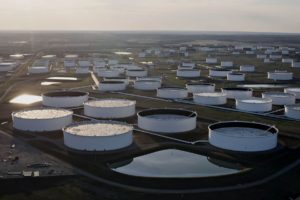

Sunday night’s 5.0 magnitude earthquake that hit Cushing, Okla., is the latest and, in some ways, the most troubling in a series of temblors that has rocked the Sooner State over the past few years. Not only did it strike within a mile of what is arguably one of the country’s most important strategic assets—Cushing is the largest crude oil trading hub in North America, with almost 60 million barrels of stored crude—but its occurrence raises questions over the state’s ability to do anything about the significant rise in seismic activity, which has been linked to oil and gas activity.
While regulations limiting the underground disposal of wastewater have succeeded in reducing the overall frequency of earthquakes, they haven’t been able to stop the really big ones from happening. With a recent flurry of quakes hitting closer to Cushing, that’s raising questions about national security risks.
Last year, Oklahoma experienced more than 1,000 earthquakes measuring at least 3.0 in magnitude; that’s up from fewer than two in 2008. The state is now the most seismically active in the continental U.S. Seismologists believe the quakes there are the result of wastewater injection wells used by the oil and gas industry.
Horizontal oil wells in Oklahoma can produce as many as nine or 10 barrels of salty, toxin-laced water for every barrel of oil, and much of that fluid is injected back underground into wastewater disposal wells. The fracking revolution resulted in an enormous increase in the disposal of wastewater underground in Oklahoma. From 2009 to 2014, disposal volumes shot up 81 percent, to more than 1 billion barrels a year. It is this wastewater, injected near faults, that many seismologists, including those at the U.S. Geological Survey, say has caused the spike in earthquakes.

After years of official skepticism over the relationship between fracking and earthquakes, Oklahoma’s government finally acknowledged the link in 2015. That came as the industry was reeling from lower crude prices, and it was a big step, considering that oil and gas accounts for about a quarter of all jobs in the state. That summer, the Oklahoma Corporation Commission, the state’s oil and gas regulator, began imposing restrictions aimed at cutting the amount of wastewater disposed of underground. To date, the OCC has ordered some 700 disposal wells either to shut down or reduce their volumes. That’s cut disposal rates by about 800,000 barrels a day, from a high of about 2.5 million in 2014.
With the added restrictions, Oklahoma has gone from averaging more than four earthquakes a day to around two per day. The reduction, in some ways, confirms the connection between wastewater disposal and earthquakes. “It’s the closest thing we have to a smoking gun,” said Jeremy Boak, director of the Oklahoma Geological Survey. But it also shows the limited power of strict regulations in reducing the largest earthquakes.
The Cushing quake was the third quake with a magnitude of 5.0 or greater so far this year in Central, the 19th temblor over the past week. It hit just two months after the biggest quake in state history, a 5.8-magnitude one in Pawnee, about 25 miles south of Cushing.
That event has muted some of the enthusiasm around the OCC restrictions, said Dan McNamara, a research geophysicist at the U.S. Geological Survey in Denver. “For about six months, the story was that these restrictions were working, but then the 5.8 hit,” said McNamara. “The small events may be trending down, but the frequency of the largest ones is going up, and that is what’s troubling about this latest cluster of activity, particularly around Cushing.”
Last year, McNamara co-authored a paper that studied a sequence of earthquakes around Cushing in 2014. His paper linked the quakes to the activity of four injection wells in the vicinity. It also uncovered a fault line directly beneath Cushing’s enormous oil tanks that was previously unknown to geologists—the same fault that was activated on Sunday. The recent seismic activity, despite a significant reduction in disposal rates, is cause for concern, McNamara said. “It tells me that there is something else going on other than the direct injection of water underground.”
Even if Oklahoma were to stop injecting wastewater tomorrow, McNamara said, the chance of large quakes will remain elevated for years to come. The pressure that fracking wastewater has added to the complex network of fault lines running beneath Oklahoma isn’t going away. “We’re looking at many, many years of earthquakes as that energy dissipates through the system,” he said.
The Cushing quake knocked out power and damaged many of the small town’s historic buildings, but no damage was reported to its oil and gas infrastructure. The oil facility resumed normal operations on Monday.
Even so, might the latest tremblers serve as a wake-up call to the industry that more must be done to prevent what could ultimately become a national catastrophe? “I don’t think this changes anything,” said Kim Hatfield, vice chairman of the Oklahoma Independent Petroleum Association, a trade group of oil and gas producers. The industry still strongly opposes any moratorium on wastewater disposal, said Hatfield.
Although big fracking companies are exploring options on how to treat and recycle their wastewater, rather than inject it underground, the industry insists those options still aren’t cost-effective and that a disposal moratorium would destroy the state’s economy by shutting down oil production. “If you shut down wastewater disposal, there won’t be anything left to regulate,” said Hatfield. “So that is an awfully expensive science project you’d have there.” It’s also an awfully risky chance to take.
Related:
Safety Experts: Oklahoma Quakes a National Security Threat